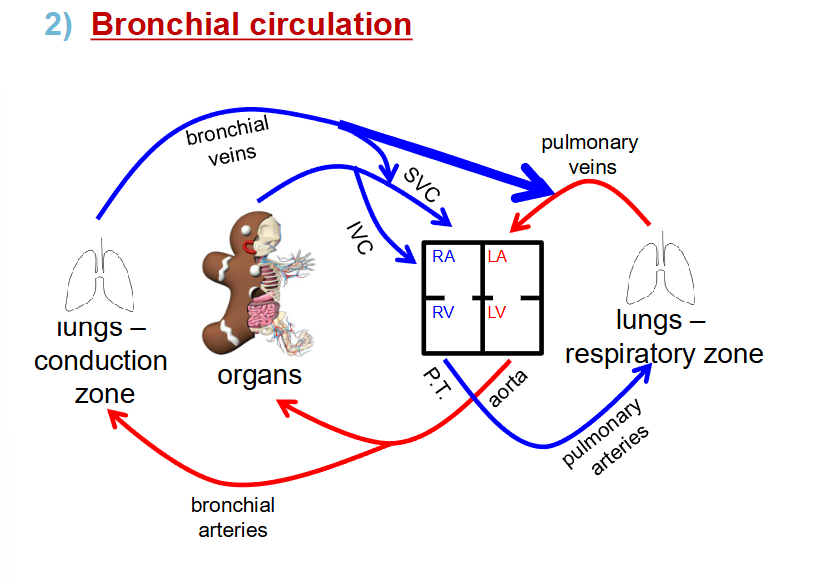-
What are the main functions of the respiratory system?
- ventilation (air movement into and out of lungs)
- exchange of gases (O2 and CO2) between lungs and blood
-
What are the 2 subdivisions of the respiratory system? And what are is included in those subdivisions?
- upper respiratory system (nose, nasal cavity, pharynx)
- lower respiratory system (larynx, trachea, bronchial tree, lungs)
-
What is the mucosa on most of the respiratory tract?
- ciliated pseudostratified epithelium with goblet cells sitting on the lamina propria (CT)
- goblet cells secrete mucous
- cilia sweep mucous to esophagus where swallowed
-
What are the respiratory system organs?
nose, nasal cavity, paranasal sinuses, pharynx (throat), larynx (voice box), trachea, lungs, bronchial tree, and the respiratory membrane
-
What is the nose supported by?
- supported by bone and hyaline cartilage
- nostrils are called nares
-
What are the functions of the nasal cavity?
- airway passage (warms, moistens, and filters air)
- olfaction (sense of smell)
- speech (resonance chamber)
-
What are the two areas divided by the nasal septum?
- anterior part = hyaline cartilage
- posterior part = vomer, ethmoid, maxillae, palatine bones
-
What are the 3 areas of the nasal cavity?
vestibule, respiratory area, and olfactory area
-
What is the vestibule?
- anterior region of the nasal cavity
- no mucosa; lined by thin skin with hair that filters particles (e.g. dust, pollen)
-
What is the respiratory of the nasal cavity?
- posterior region
- chonchae protrude medially from lateral walls of cavity
- air passes through meatuses (channels between chonchae) this causes air turbulence that helps humidify air and trap dust on ciliated epithelium
-
What are the names and projections of the nasal chonchae?
o superior (projection of the ethmoid)
o middle (projection of the ethmoid)
o inferior (separate bones referred to as the inferior nasal chonchae)
-
What is the nasolacrimal duct?
nasolacrimal duct connects the medial region of eye to the inferior nasal meatus, allowing lacrimal fluid (which includes tears) to drain into nasal cavity
-
Where is the olfactory area? What does it do?
- found in roof on nasal cavity
- mucosa contains olfactory neurons that are sensory receptors for the sense of smell
-
What are paranasal sinuses?
- 8 air filled spaces in the skull (4 pairs)
- open directly into nasal cavity
- warms and moistens air (& makes skull lighter)
-
What are the 8 spaces of paranasal sinuses?
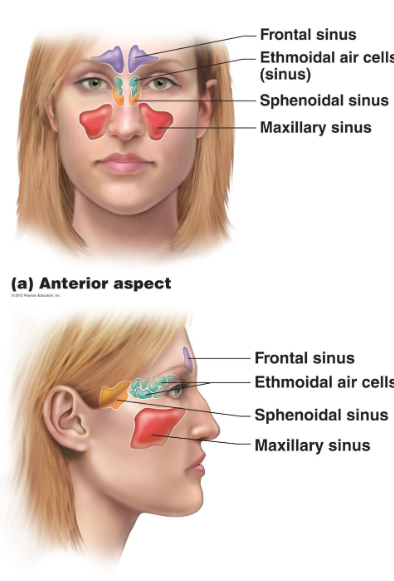
-
What is sinusitis?
when the mucous membrane becomes inflamed due to infection
-
What is the pharynx (throat) made of?
- walls are formed of skeletal muscle lined by mucous membrane
- made up of 3 interconnected regions (nasopharynx, oropharynx, laryngopharynx)
-
What is the nasopharynx?
- located posterior to nasal cavity, passage for air only
- contains pharyngeal tonsils on posterior wall
- openings: 2 posterior nasal apertures (connects to nasal cavity)
2 pharyngotympanic (auditory) tubes (connects to middle ear)
-
What is the oropharynx?
- posterior to oral cavity, contacts food and air from soft palate to top of epiglottis
- epithelium of mucosa is stratified squamous epithelium
- contains palatine tonsils and lingual tonsils
-
What is the laryngopharynx?
- posterior to larynx (from epiglottis to opening of larynx)
- epithelium of mucosa is stratified squamous epithelium
- contacts both air and food
-
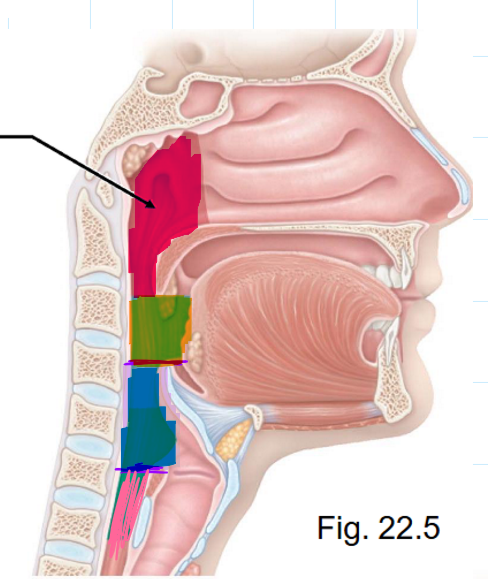
red: nasopharynx
green: oropharynx
blue: laryngopharynx
-
What is the larynx (voice box)?
- anterior to laryngopharynx
- air passageway that connects the pharynx to the trachea
contains/made of: 8 hyaline cartilages and 1 elastic cartilage (epiglottis), vocal cords, and glottis
-
What does the epiglottis do?
- its flexible and covers the glottis during swallowing to prevent food entering the larynx
-
What are vocal cords (ligaments)?
- 2 sets of paired folds under the laryngeal mucosa in the mid-larynx
- vestibular folds (are the superior folds, called "false vocal cords", and help close the glottis)
- vocal folds (are the inferior folds, called "true vocal cords", and produce sounds by vibration)
-
What is the glottis?
- includes the vocal folds (true vocal cords) and the opening between them
the opening between the vocal folds in the larynx that is generally thought of as the primary valve between the lungs and the mouth
-
What is laryngitis?
inflammation of larynx due to infection or irritation
-
What is the trachea?
- anterior to esophagus (air only)
- consists on 20 C-shaped pieces of hyaline cartilage (open face of C faces esophagus, permitting esophagus expansion)
-
What does the trachea connect?
- connects larynx to main bronchi (the two main bronchi branches off trachea to each lung)
-
What makes up the lungs?
- right and left are separated by mediastinum
- pleura (serous membrane, visceral on lung, parietal on inner thoracic wall, superior diaphragm and mediastinum)
- pleural cavity (prevents friction with serous fluid when lungs move, holds lungs to thoracic wall)
-
How many lobes to the right and left lung have?
- right lung (3 lobes, superior, middle, and inferior)
- left lung (2 lobes, superior and inferior, has cardiac notch (where heart lies))
-
What is the bronchial tree?
- air passageway that repeatedly branches into smaller passageways
- connects trachea to alveoli of lungs
- extends from left and right main bronchi to alveolar ducts
- consists of conduction zone structures and respiratory zone structures
-
What does the conducting zone consist of?
- 2 main (primary/1st level) bronchi (left and right)
- 5 lobar (secondary/2nd level) bronchi (3 right, 2 left)
- segmental bronchi (multiple levels of branching)
- terminal bronchioles (multiple levels of branching)
-
How does the epithelium of mucosa transition in the bronchi?
transitions from ciliated pseudostratified epithelium in larger bronchi to ciliated simple cuboidal epithelium in terminal bronchioles and respiratory bronchiles to non-ciliated simple squamous in alveolar ducts
-
What are respiratory zone structures? What do they consist of?
- sites of gas exchange (O2 enters blood, CO2 leaves)
made of: respiratory bronchioles (multiple levels of branching)
- alveolar ducts (tips of bronchial tree)
- alveoli (millions, main site of gas exchange, form part of respiratory membrane)
-
Describe the respiratory zone structures?
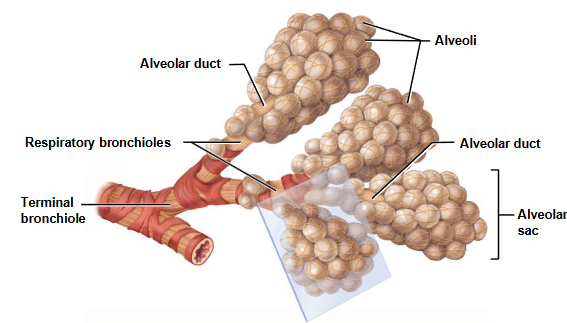
-
How does the mucosa change throughout the entire respiratory system?
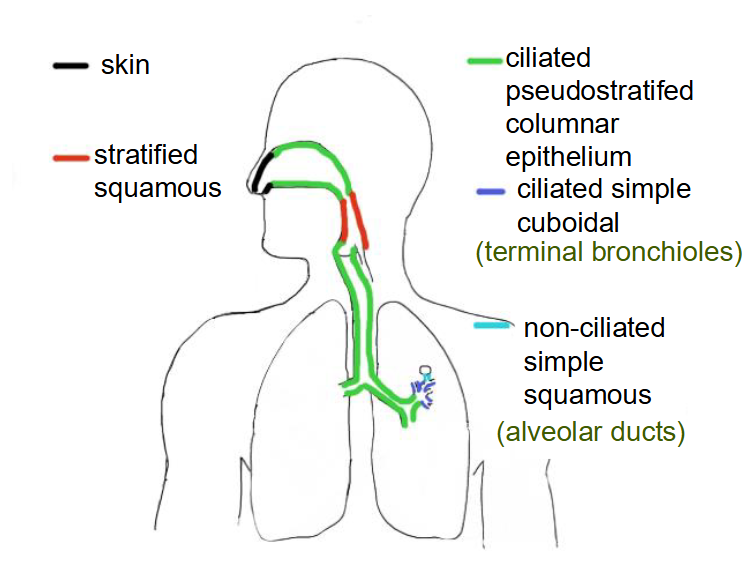
-
How do the airways branch out? (chart)
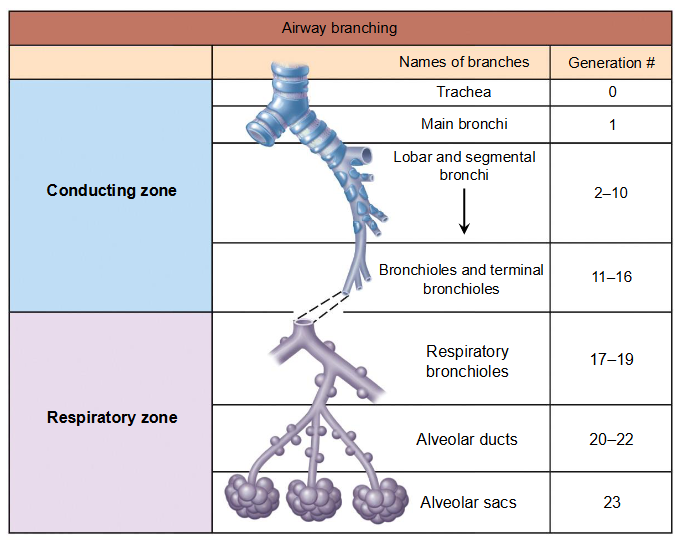
-
What is the respiratory membrane?
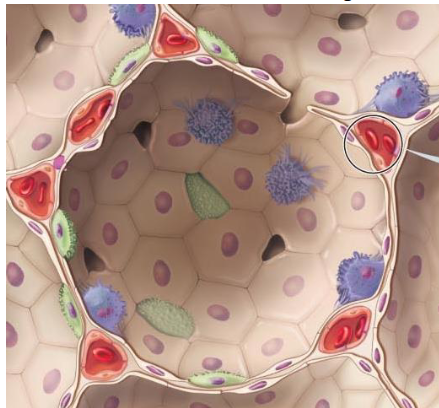
3 layers (2 epithelia and their fused membrane)
- wall of alveolus
- basement membranes of alveolus and capillary
- wall of capillary (simple squamous epithelium (endothelium))
-
What is the wall of alveolus made of?
- simple epithelium
- 2 cell types (type 1 and 2 alveolar cells)
- alveolar pores (openings) allow air movement between adjacent alveoli
- macrophages (freely move between blood and alveoli, remove dust, cellular debris, and pathogens)
-
What are the two types of alveolar cells?
Type 1: simple squamous, allows gas diffusion
Type 2: simple cuboidal, secrete surfactant (molecule that covers inner surface of alveoli, reducing attractive forces between water molecules making it easier for alveoli to expand during inhalation)
-
What is the route for pulmonary circulation?

-
What is bronchial circulation?
- subdivision of systemic circulation
- blood to nourish lung tissue
- bronchial arteries: arise from aorta, carry oxy blood to lung tissues (bronchi) but not respiratory portion
- blood to heart returns via bronchial vein (little blood) to right atrium or pulmonary veins (most blood) to left atrium
-
What is the route for bronchial circulation?
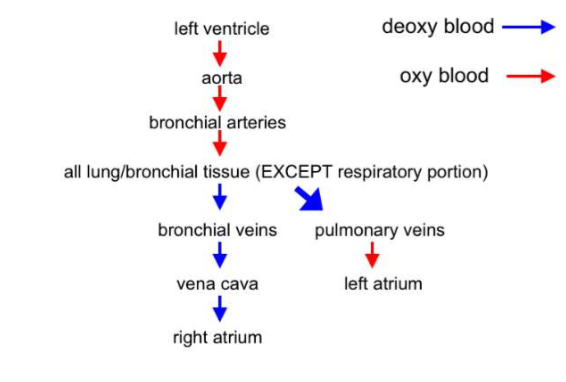
-
What is pulmonary edema?
- accumulation of fluid in the lungs (between cells and within alveoli)
-
What is pulmonary embolism?
- blockage of pulmonary vasculature
- results from blood clots, arteriosclerosis, air bubbles in vessels, etc.
-
What is the route for bronchial circulation in relation to the heart and organs?
